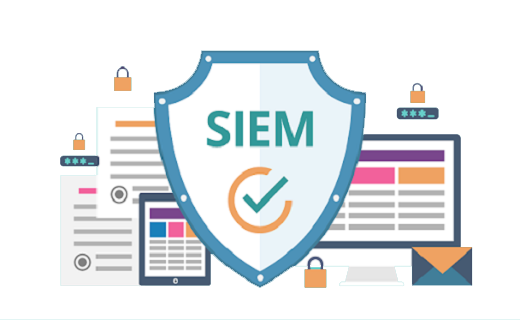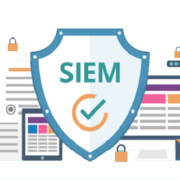SIEM – Security Information & Event Management Service & Solutions
Continuously monitor data flows for sophisticated event management. Real-time analysis of SIEM data and incident reporting. Integrate intelligent security tools for automatic threat mitigation and response

SIEM Platform: The Core of SOC Operations and Information Security Management
Although organizational operations and tasks may be planned, assaults are not. With the exponential growth of intentional and unexpected assaults, hardly a single second is secure. The Security Operations Center Team of an organization must be always vigilant in evaluating telemetry and data from many sources, integrating sophisticated threat hunting and incident investigation, and initiating prompt actions. SIEM is an essential pillar for protecting an organization’s IT infrastructures end-to-end in the middle of this “chaos” that is far simpler to record than to act in.
SIM (Security Information Monitoring) and SEM (Security Event Management) are two separate functions of SIEM (SEM). As a fundamental component (subset) of SOC operations, this entails continuous interaction with real-time logs/information and threat monitoring throughout a company’s networks, applications, data, IT infrastructure, and cloud environments. Once a breach is identified by SIEM tools or software, the SIEM team is immediately notified and intelligent analysis and response processes are orchestrated. Modern SIEM products and infrastructures provide even more features, including in-depth security analytics, easy reporting, and self-healing via integration with powerful SOAR, threat remediation systems.
What is managed SIEM and why is it important?
The majority of the over 200 million SMBs’ IT departments are understaffed. While they labor hard every day to maintain landscapes and processes, asset security monitoring suffers. On the other hand, building a specialized SOC or SIEM team to monitor security events 24 hours a day, 7 days a week, and identify threats is exorbitantly costly and strains IT resources.
CDWT’s end-to-end Managed SIEM solutions and services provide the required assistance. A certified, world-class cybersecurity team monitors threats around-the-clock using SIEM solution integration, log/information analysis, and event management throughout the whole IT and cloud stack. The CDWT SOC and SIEM team and security analysts deploy advanced SIEM software and SIEM tools such as IBM QRadar with custom capabilities, provide real-time threat visibility and detection-priority support, intuitive user activity dashboards and data reports, high-end security analysis for actionable plans, and a master console for integrating additional intelligent security solutions. Enhance corporate security with up-to-date, updated frameworks and strict adherence to local, national, and international compliance requirements.
SIEM Capabilities: Events Monitoring and Management Administration, Automation, and Modernization
- Analytical Security Intelligence
- Security Observation
- Alerts Management
- Reporting
- Compliance Administration
- Threat Detection
- Incident Response
- Automation of Risk Management
- Security Improvement


















Examining the SIEM Integration and Connectivity Map
Security Events & Incidents
-
Threat detection systems
-
Endpoint protection using anti-virus, anti-malware, and anti-threat software
-
Data Loss Prevention
-
VPN solutions
-
Web-filters
-
User touchpoints
-
Firewalls
-
Vulnerability Assessment Tools
-
Networks
-
Routers
-
Switches
-
DNS Servers
-
Wireless Access Points
-
WAN
-
Data Transfers
-
Virtual Private Cloud Architectures
-
Applications & Devices
-
App servers
-
Databases
-
Intranet connections & Apps
-
Web Apps
-
SaaS Apps
-
End-user laptops, desktops, and other connected devices
-
Mobile Devices
-
Applications & Devices
-
Configuration Systems
-
External infra locations
-
Owners & Administrative systems
-
Network Maps
-
Software Inventory
-
Public, Private, Hybrid Cloud Environments
-
Multicloud architectures
-
PaaS, IaaS Architectures
-
ITSM frameworks
-
Completely Managed SIEM Solutions and Services from CDWT
- Collection of Log Information and Data
- Correlation of Security Events and Alerting
- Cyber Threat Monitoring and Incident Analysis in Real-Time
- Exhaustive Threat Investigation
- Enhanced Security Incident Reporting and Analytics
The SIEM technology uses robust tools and processes to collect all security data flows, logs, attack histories, and other pertinent data from the entire IT and cloud stack end-to-end: applications, systems, platforms, architectures, Operating systems-middleware, network devices, web servers, libraries and protocols, VMs, servers, networks, endpoint environments, IoT landscapes, and more. Most SIEM systems aggregate log data from event logs while connecting to a variety of sources. However, CDWT's installed SIEM solutions guarantee that sophisticated entity behaviour analytics are used to gather and analyse data at a deeper level. The data is evaluated automatically (or under the guidance of a team) to find or anticipate latent hazards. Guarantee total data security for sensitive data and standard data procedures.
Upon real-time receipt of logs and process data from all assets, the SIEM system executes event, risk, anomaly, or historical pattern-based analysis to correlate the data footprints with potential security breach occurrences. Once an event or problem occurs, the affected parties are immediately alerted through security alerts for investigation and remedy. In addition to analysing produced alerts based on general user activity patterns, correlation rules, and false positive filtering, advanced SIEM systems also evaluate alerts based on general user activity patterns. This decreases stress for the security, administration, and IT teams significantly.
In partnership with the SIEM team, the SIEM tools and platform monitor the IT environment end-to-end, including data, applications, networks, enterprise systems, key systems and devices, virtual machines (VMs), and cloud architectures. Utilizing cutting-edge behavioural analytics from different data sources, event correlation and event data, threat research, and intelligent security analytics technologies ensures the instantaneous discovery of unknown, hard-to-find threats from any source. Prioritize external and internal risks based on their effect capabilities in order to create an appropriate, rapid action framework and cutting-edge event management systems.
Frequently, SIEM tools and platforms are connected with Deep Outsider and Insider Threats hunting, investigation, and Threat research-discovery platforms to undertake rigorous evaluation and deep monitoring of the complete IT infrastructure and cloud stack. This facilitates the identification of hidden threats, malicious code, unusual behaviours, and even ostensibly innocent foreign files that might be used in the future to launch an attack.
CDWT has implemented SIEM systems that use cutting-edge AI to conduct in-depth security analyses. Common end-to-end analytics security features and frameworks include User Behavior Analytics (UEBA), MITRE ATT&CK techniques, contemporary regulations, etc. After conducting a comprehensive investigation and analysis, the system generates understandable security reports and enables intelligent overview dashboards. This alleviates excessive security worries by providing customers with cutting-edge risk visualization for informed decision making.
- Examination of Security Data and Forensics
- Integration of Threat Response Management and SOAR
- SIEM-based Cloud Security Incident Management
- Integration of Threat Intelligence and Automation
- Audit and Compliance Management for SOC
Ensures military-grade data security analysis on all logs and dataflows managed by the system. Examines deep-level threats, non-signature dangers, and predictable vulnerabilities using extensive, sophisticated tests based on the most current security standards. Enables Data obfuscation so that all sensitive data is appropriately concealed. Advanced incident forensics guarantees that all attacks (occurred or expected) are properly tracked back to their underlying cause, allowing for swift cleanup and infra upgrades for future continuous protection.
Traditional SIEM systems, methods, and teams are solely concerned with threat monitoring, investigation and alerting, and breach analysis. However, current SIEM systems provide the necessary interfaces to synchronise with infrastructure endpoints and architectures responsible for initiating threat remediation, especially SOAR (Security Orchestration and Automation Response). With this enhanced SIEM, SOC teams may launch automated threat response procedures with increased agility and efficiency, therefore establishing an automated, intelligent threat management lifecycle that is close to end-to-end.
Synchronize the adopted SIEM solution, SIEM tool, procedures, and resources with private, public, hybrid, and multicloud systems for top cloud platforms, including AWS, GCP, Azure, Oracle Cloud Infrastructure, IBM Cloud, and others. Protect your SaaS applications, PaaS infrastructures, and IaaS solutions with a sophisticated SIEM system for unwavering threat/incident investigation, monitoring, analysis, and reaction for cloud workloads. Connect SIEM tools and processes with cloud log management portals, monitoring, and native security tools to provide a more flexible, comprehensive, and sophisticated cloud security solution.
Adopt SIEM-integrated Managed Security Center Operations or SOC services to combine cutting-edge threat intelligence and automation solutions into organisational workflows or CSIRT, SIEM operations. Integrate advanced threat intelligence feeds - a constant stream of threat data from end-to-end of the IT environment fed into the Security Information and Event Management (SIEM) platform. IP/Domain Reputation, File Reputation, CWPP, CSPM, CASB, Phishing-malware-ransomware feeds, and IT assets management should be consolidated. Utilize the patented Self Healing or Preventive Maintenance Platform to not only decrease Meantime to Detect and Meantime to Repair, but also eliminate hazards via enhanced risk prediction and automated risk healing procedures. Under the direction of a world-class SIEM team, modernise cybersecurity administration by using AI-powered solutions.
Utilize specialised knowledge and cutting-edge SIEM technologies to undertake in-depth Security Operations analysis, audits, and Compliance Reporting. Compliance-related complexities and lack of security team experience can result in significant IT process gaps inside a business. This might be an enticing offer for hackers. As part of the expanded SOC-as-a-service package, CDWT's compliant-ready products guarantee that client facilities are compatible with data localization-residency legislation, national regulations, local compliances, and international certifications. Compliance adherences, including but not limited to:
- IRAP
- Bank Negara
- Central Bank of Oman
- SAMA
- FINMA
- UAE Compliances
- RBI
- MAS
- OJK
- GDPR
- CSA
- PCI-DSS
- HIPAA
- GXP
- International Standards: ISO-27001, ISO-27017, ISO-27018, ISO-22301, ISO-20000, AICPA SOC, AICPA SOC2
Models of SIEM Solution Deployment
On-prem, Self-Managed
-
Traditional deployment strategy in which the SIEM solution is placed inside the client's data centre and integrated with the organization's IT operations. In addition to platform maintenance, the SIEM and SOC teams leverage the installed SIEM system to get log insights and threat monitoring, investigation, and reporting capabilities.
-
Private Cloud SIEM Deployment
-
The client is responsible for incident correlation, analysis, alerting, dashboards, and other security activities based on dataflows under this deployment paradigm. The Managed Service Provider collects and records dataflows and information received from the customer in order to aggregate, evaluate, and forecast potential risks. Additionally, the provider team aids in threat research, monitoring, and response coordination.
-
Hybrid SIEM Deployment, Self-Hosted
-
The customer is responsible for the hosting hardware and SIEM software deployment. SIEM MSSP is responsible for end-to-end data collection, aggregation, event correlation, incident/alert management, intrusion investigation, and report management. Additionally, the team supports with incident response orchestration and recovery
-
SIEM-as-a-Service
-
Under the SIEM-as-a-service model, The managed service provider is in complete charge of the SIEM software, hosted SIEM hardware, and all security processes along with it: threat visibility, monitoring, alerts management, reporting, response initiation, and more. The client supervises the security procedures and handles the system's information flow.
-
Cloud-native Intelligent SIEM-SOAR Solution for End-to-End Threat Management is Microsoft Azure Sentinel.
Azure Sentinel, along with Windows Defender, Microsoft Cloud App Security, and others, is the jewel in the crown of Microsoft’s sophisticated cloud security products. Microsoft Azure Sentinel is an intelligent cloud-native Security Information and Event Management (SIEM) and Security Orchestration and Automation Response (SOAR) solution for end-to-end IT security management.
The platform provides a security monitoring, threat/alert detection, proactive remediation, and intelligent security analytics solution applicable to all IT assets and resources, including computing assets, devices, servers, databases, datacenters, platforms, architectures, applications, networks, and Edge-IoT environments, among others.
Azure Sentinel links effortlessly to other security technologies, such as Windows Defender, Azure Cloud Apps Security, Azure Monitor, Log Analytics and Logic Apps, Azure AD, MITRE Frameworks for advanced threat hunting, automation tools, and more.
Features Of Azure Sentinel
Data Gathering
Effortless gathering of data from IT devices and resources, including as users, apps, hardware, and networks, on-premises as well as from numerous cloud platforms linked to Azure. Integrate Azure-native and non-Microsoft security solutions with ease to create a more robust IT security ecosystem backed by Sentinel.
Global Observability and Analytics
Extend security analytics and real-time insight throughout the whole IT ecosystem. Correlate alarms into events to initiate automatic operations, implement Anomaly Detection based on Machine Learning, map network and user activity data, and make educated cybersecurity management judgments.
Superior Threat Investigation and Hunting
Acquire dynamic, intuitive, and comprehensive threat analysis skills across all IT resources and different cloud, edge, and IoT ecosystems. Prepare unique warning criteria, discover risk alerts and threats previously ignored, and engage in advanced threat hunting using the capabilities of Azure Sentinel's artificial intelligence. Utilize Azure Sentinel's robust hunting search and query capabilities supported by the MITRE architecture to proactively explore the IT landscape of the enterprise for threats.
Utilizing Security Automation and Orchestration for Threat Mitigation
Azure Sentinel's cognitive security automation and orchestration capabilities automate typical threat management operations across the enterprise. Integrate Sentinel with Logic Apps, Logic Analytics, Azure Functions, 200+ connectors for other Azure services, and corporate tools like as Jira, Zendesk, Slack, and Microsoft Teams, among others, to unleash end-to-end automated security management.
CDWT Azure Sentinel Managed Services
Azure Sentinel Deployment
-
Perform a comprehensive assessment of the client's IT environment, processes, and dataflows, including alerts and modifications.
-
Collect client specifications and propose upfront cost savings for using Sentinel.
-
Use Case creation to improve customer visibility in the cloud environment
-
Analyze log types and devices, both on-premises and in the cloud, and determine the appropriate data sources required to support use cases and the migration to the cloud.
-
Assist in onboarding log activities
-
Configuring Sentinel and importing log data using both native and custom Sentinel connectors.
-
Configuring dashboards and alerts
-
Creation of Threat Hunting templates and notification circumstances
-
The creation of playbooks that automatically run when an alert is triggered.
-
Knowledge transfer, training in detection and response, and document development for client usage.
-
Azure Sentinel Management
-
Continuous Fine-Tuning of Infrastructure-Specific ATT&CK-Based Rules and Compliance Policies
-
Conduct Incident management with a focus on Root cause analysis and mitigation.
-
Provide weekly and monthly updates on the security posture and developments, along with information that may be used to enhance the security posture.
-
Technical account manager from the SOC with comprehensive knowledge of the client's infrastructure. Auto-remediation of incidents in minutes without human participation decreases incident response SLA and reduces total staffing costs.
-
The detailed forensics service provided an on-demand team of cyber threat intelligence specialists that conducted threat hunting.
-
Recommendations based on threat modelling and a comprehensive knowledge of infrastructure. Even for apps that cannot send logs, custom data collecting is supported. Creating bespoke parsers for even unstructured logs.
-
Continual identification of vulnerabilities and misconfigurations in conjunction with real-time business processes and capabilities.
-
Detection and Response (EDR) notifications to provide breach information on a global scale. Correlation of Endpoint asset vulnerabilities
-
During in-depth incident investigations, identify Machine-level vulnerabilities.
-
Based on the business context and the ever-changing threat environment, prioritise cleanup. Integrated remediation procedures with Microsoft Intune and Microsoft
-





